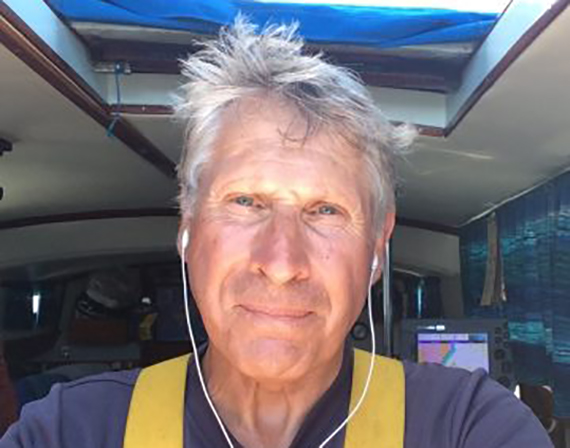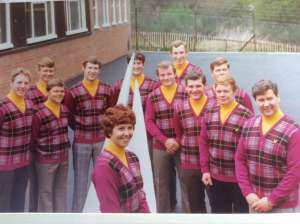
As a small boy I grew up in Wallasey near the River Mersey. I loved to climb at a rocky sandstone outcrop call the Breck. The Breck sits on a ridge 80 feet above sea level over looking Bidston hill and Leasowe.
The Breck was an old quarry but the central feature is a single standing triangular shaped sandstone rock called the Granny Rock. I started climbing this rock when I was probably 8 or 9.
One side is comparatively easy to climb so I soon worked my way to the top.
The Breck, Wallasey PDF
One of the sides of the triangular rock is virtually sheer, but the famous side to climb has an overhang from the Granny chair, which was large hollow indentation about 2/3rds the way up, ideal resting place before you attempt the overhang to the top.
It took me a number of attempts before I was able to negotiate the overhang from the Granny chair. I use to take great satisfaction watching older boys getting stuck in the Granny chair, not able to go up or down. The local Fire brigade on many occasions was called out to rescue a young climber.
One day I saw a group of young boys dressed in battle dress on military manoeuvres at the Breck. I wondered who they were? it was the local army cadet unit. When I was older I joined the 64th Cheshire Yeomanry Army Cadet Force. I remember a saying to this day, “the 64th in (19) 64”. The adult instructors taught us map reading, field craft, skill at arms, drill and lots of spit and polish.http://armycadets.com
A few years later when I was 18 the Royal Marine Reserve Merseyside were looking for recruits, I thought that sounds interesting? It wasn’t long before I was doing my basic military training in Eastney barracks in South Sea and than soon afterwards going to the Commando Training Centre at Lympstone, on the banks of the river Ex in Devon.
CTC was the physical fitness selection course for the coveted green beret. Whilst serving with the RMR I volunteered for the parachute training course at No.1 Parachute Training School at RAF Abingdon.
I loved the thrill of military parachuting and the military life, once I finish my engineering apprenticeship I wanted to join the regular Royal Marines. Unfortunately I failed the medical due to a colour perception test, as I have slight colour deficiency. I was obviously disappointed but not totally demoralised, what about the Army? They always looking for recruits?
With my engineering background I applied to join the Corp of Royal Engineers. I enlisted in 1972 and was sent to Cove Farnborough at the No1 Training Regiment R.E. After around 16 weeks at Cove we had a visit from a Sergeant and Corporal from 9 Independent Parachute Squadron R.E. who required new recruits to join 9 Para Squadron. The Sgt was called Tom Downie who was a charismatic character with a roguish temperament.
On completion of my military engineering training about dozen of us from my recruit troop went to 9 Para Sqn R.E. at Aldershot to undertake the pre para and the para selection training course. All budding paratroopers must pass “P Coy” or Para Company before going to the Royal Air Force parachute school.
By end of the first week of pre para none of us could walk properly. We had so many physical aches and pains, caused through speed marching, over long valley a tank training area near Aldershot, and our daily sheer physical exertions. By the end of the first week I was only remaining recruit from my R.E. training troop left on the pre para course.
Cut a long story short I eventually made it to P Coy and passed the course at end of December 1972. Remarkably I achieved best all round personal P Coy performance for that course. It was sheer will power on my part, because at the beginning of P Coy I use to be at the back of the speed marching squad, I thought I must work my way to the front on each every speed march, being at the back on speed marches was always demoralising.
What are speed marches? Speed marches are designed to get fully equipped paratroopers carrying his rifle, ammunition, personal food supplies contained in both his belt kit and his Bergen back pack quickly from drop zone to the battle field. Hence the speed march which is fast paced marching alternated with running. In para parlance the “TAB” tactical assault to battle. You’ve got to be extremely fit, tough and resilient to keep up with a fast marching squad of paratroopers.

Scouse as young Non commission Officer in Northern Ireland.
Now you might be thinking what’s this long military story got to do with sailing? I would say everything and why? Because a few years later on general orders for 16 Independent Parachute brigade an ex parachute regiment Sergeant named Chay Byth was looking for new crew members for his next sailing adventure on GB 111 his new sailing trimaran.
Chay Byth previous adventurous undertakings had been the first two man crossing of the North Atlantic in a dory rowing boat from Newfoundland to western Ireland in the mid 60’s with fellow paratrooper John Ridgeway.
He’d also entered the first round the world Golden Globe yacht race, having no previous sailing experience, but pulled out when he arrived in South Africa when he realise his yacht wasn’t designed for sailing in the southern oceans.
But his main claim to fame was his solo circumnavigation of the globe against the prevailing westerly winds in the sailing Yacht British Steel. He then went on to skipper GB 11 on to the first round world Whitbread yacht race of 1972. His sponsor was British tycoon ex pat Jack Haywood based out in the Bahamas.
In those days there was no formal sail training you were thrown straight into the deep end. After passing a short selection up in Harwick Scotland where Chay was born, we got right down to sailing on GB 11 which had just completed the first round the world Whitbread race with another crew of paratroopers.
To be fair I hadn’t got a clue what I was doing? there were ropes strewn all over the deck, it was mind boggling. But slowly but surely I got to grips with things. Another 9 Para Sqn RE crew member Billy McCormick, who was a strong steady Scotsman, he and I were to become foredeck crew responsible for looking after the foredeck sail changes.
Those days there were no sail furling systems it was all hanked on sails. GB 111 was under construction at Wicor marine at Farnham Creek. The trimaran was quite revolutionary for those days and it had lovely lines, designed by Derek Kelsall.
After it was built we did a test sails and it had rather strange motion at the bow and use to vibrate up and down when at speed. When we undertook a serious training passage across the bay of Biscay on passage to Portugal we lost the large centre board in fairly rough sea conditions. Fortunately we didn’t take on too much water and got back to Dartmouth safely.
Unfortunately the trimaran race was cancelled and the crew were disbanded. Not sure what happened to GB 111? I know that Chay Byth and Eric Blunn another paratrooper did try a special one off challenge from New York to San Francisco around Cape Horn on the trimaran called Beefeater. But she capsized and was sank off the Falklands. Luckily they were both rescued by the Chilean navy.

Great Britain 111

Trimaran Crew Of Great Britain 111 with Chay Blyth and his then wife. I’m 4th from the left.
I didn’t do anymore sailing until I was in my early 50’s did Yachtmaster fastrack course with British Offshore Sailing School of BOSS on the Hamble near the Solent.
I bought my first sailing boat in 2004 Camper & Nicholson 32 Barada from a retired Royal Airforce Air Vice Marshall Ted Hawkins at Lymington.

Air Vice Marshall Ted Hawkins.
Barada was wonderful sea kindly boat and under took Atlantic crossing to the Caribbean, solo Canary Island sojourn. 2020 a solo sail to Venice from the east coast of England.
I have this love of adventure which I can’t quell, hence my purchase of Stella Polaris for my future sailing projects.
Interested in Adventure
Sailing?
Once we go beyond the seas horizon we depend upon ourselves and must rely on our small boats for our ultimate safety.